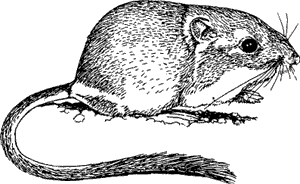Kangaroo Rats | Kangaroo Rat Overview | Kangaroo Rat Damage Assessment | Kangaroo Rat Damage Management | Kangaroo Rat Resources | ICWDM | Wildlife Species Information
Figure 1. The Ord’s kangaroo rat, Dipodomys ordi.
Identification and Range
There are 23 species of kangaroo rats (genus Dipodomys) in North America. Fourteen species occur in the lower 48 states. The Ord’s kangaroo rat (D. ordi, Fig. 1) occurs in 17 US states, Canada, and Mexico. Other widespread species include the Merriam kangaroo rat (D. merriami), bannertail kangaroo rat (D. spectabilis), desert kangaroo rat (D. deserti), and Great Basin kangaroo rat (D. microps).
Kangaroo rats are distinctive rodents with small forelegs; long, powerful hind legs; long, tufted tails; and a pair of external, fur-lined cheek pouches similar to those of pocket gophers. They vary from pale cinnamon buff to a dark gray on the back with pure white underparts and dark markings on the face and tail. The largest, the giant kangaroo rat (D. ingens), has a head and body about 6 inches (15 cm) long with a tail about 8 inches (20 cm) long. The bannertail kangaroo rat is approximately the same size, but has a white-tipped tail. The other common species of kangaroo rats are smaller. The Ord’s kangaroo rat has a head and body about 4 inches (10 cm) long and a tail about 7 inches (18 cm) long.
General Biology, Reproduction, and Behavior
Kangaroo rats breed from February to October in southern desert states. The breeding period is shorter in the northern states. The gestation period is approximately 30 days. Reproductive rates vary according to species, food availability, and density of rodent populations. Females have 1 to 3 litters of 1 to 6 young per year. The young are born hairless and blind in a fur-lined nest within the tunnel system. Usually, the young remain in the nest and tunnel for nearly a month before appearing aboveground.
Only a few females will breed after a prolonged drought when food is in short supply. Most females will bear young when food is abundant, and some young females born early in the season will also produce litters before the season ends.
All kangaroo rats build tunnels in sandy or soft soil. The tunnel system is fairly intricate, and consists of several sleeping, living, and food storage chambers. The extensive burrowing results in a fair amount of soil being brought up and mounded on the ground surface. These mounds can be mistaken for prairie dog mounds, particularly when observed on aerial photographs. They may vary in size but can be as large as 15 feet (4.5 m) across and up to 2 feet (60 cm) high.
Kangaroo rats are completely nocturnal and often plug their burrow entrances with soil during the day to maintain a more constant temperature and relative humidity. They are often seen on roads at night, hopping in front of headlights in areas where they occur.
Kangaroo rats often occur in aggregations or colonies, but there appears to be little if any social organization among them. Burrows are spaced to allow for adequate food sources within normal travel distances. Spacing of mounds will vary according to abundance of food, but well-defined travel lanes have been observed between neighboring mounds.
When kangaroo rats are locally abundant, their mounds burrow openings, and trails in vegetation and sand are conspicuous features of the terrain. Both the number of burrows and individuals per acre (ha) can vary greatly depending on locality and time of year. There are usually many more burrow openings than there are rats. Each active burrow system, however, will contain at least one adult rat. There could be as many as 35 rats per acre (14/ha) in farmlands. In range-lands, 10 to 12 rats per acre (4 to 5/ha) is more likely. Kangaroo rats do not have large home ranges; their radius of activity is commonly 200 to 300 feet (60 to 90 m), rarely exceeding 600 feet (183 m). They may move nearly a mile (1.6 km) to establish a new home range.
Kangaroo Rats | Kangaroo Rat Overview | Kangaroo Rat Damage Assessment | Kangaroo Rat Damage Management | Kangaroo Rat Resources | ICWDM | Wildlife Species Information
Habitat
Kangaroo rats inhabit semiarid and arid regions throughout most of the western and plains states. The Ord’s kangaroo rat is the most common and widespread of the kangaroo rats (Fig. 2). Several other species are located in Mexico, California, and the southwestern United States. They generally are not found in irrigated pastures or crops, but may be found adjacent to these areas on native rangelands, especially on sandy or soft soils. They also invade croplands under minimum tillage in these areas, particularly areas under dry farming.
Food Habits
Kangaroo rats are primarily seed eaters, but occasionally they will eat the vegetative parts of plants. At certain times of the year they may eat insects. They have a strong hoarding habit and will gather large numbers of seeds in their cheek pouches and take them to their burrows for storage. This caching activity can cause significant impact on rangeland and cropland. They remove seeds from a large area, thus preventing germination of plants, particularly grasses, in succeeding years. Since these rodents do not hibernate, the seed caches are a source of food during severe winter storms or unusually hot summer weather. Kangaroo rats are quite sensitive to extremes in temperature and during inclement weather may remain underground for several days.
Volney W. Howard, Jr. Professor of Wildlife Science. Department of Fishery and Wildlife Sciences. New Mexico State University. Las Cruces, New Mexico 88003


